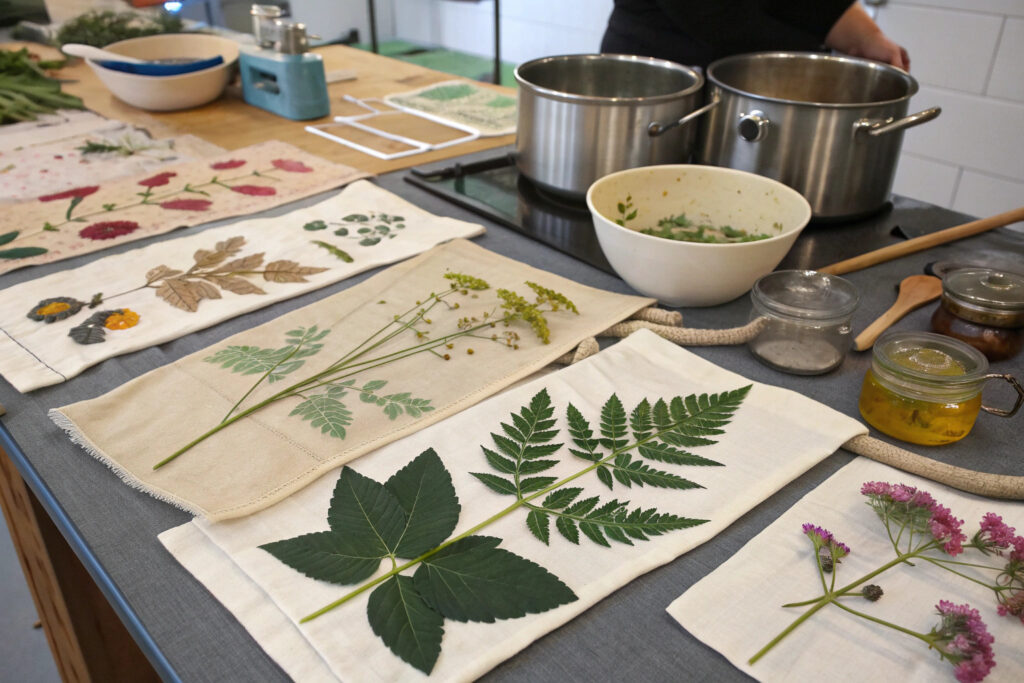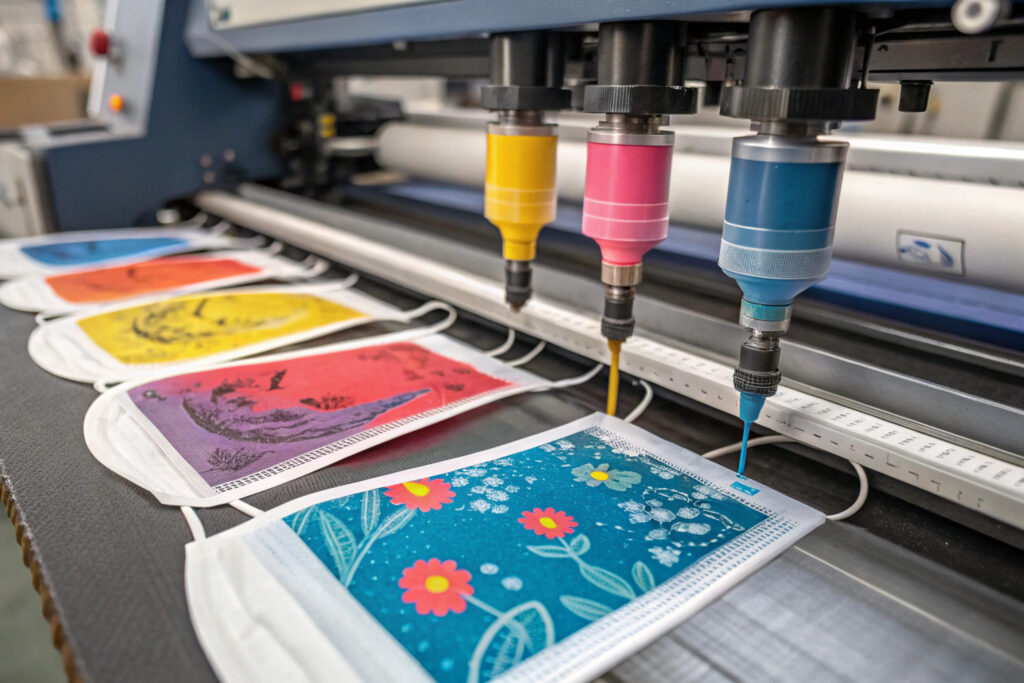The demand for sustainable decoration methods on organic fabric masks has grown significantly as consumers seek products that align with their environmental values. Water-based eco-printing offers a compelling alternative to conventional printing methods, combining artistic appeal with minimal environmental impact. This approach transforms mask surfaces into unique works of art while maintaining the integrity of organic certifications and fabric breathability.
The main options for water-based eco-prints on organic fabric masks include botanical contact printing, low-impact pigment printing, digital sublimation with water-based inks, and natural dye block printing—each offering different aesthetic effects, durability characteristics, and environmental benefits. These methods avoid the synthetic chemicals and heavy metals found in conventional printing while creating distinctive, earth-friendly designs.
Water-based eco-printing represents a fundamental shift from traditional mask decoration, focusing on natural materials, reduced water consumption, and biodegradable components. The most successful implementations balance artistic vision with technical feasibility, creating masks that are both beautiful and responsibly produced. Let's explore the specific techniques that deliver environmental responsibility without compromising visual appeal or performance.
What Botanical Contact Printing Methods Create Natural Designs?
Botanical contact printing transfers patterns directly from plants to fabric through natural pigments, creating truly unique designs.

How does plant immersion printing work?
Direct contact printing involves arranging leaves, flowers, or other plant materials directly on pre-mordanted organic fabric, then steaming or boiling to transfer pigments, shapes, and textures. This method creates one-of-a-kind patterns where each mask becomes a unique piece of art. The process uses natural mordants like alum, iron, or tannin from plants to fix the colors rather than synthetic fixatives. Our botanical prints on organic cotton masks achieve remarkable detail, capturing even delicate leaf venation patterns.
What about eco-printing with bundle dyeing?
Bundle dyeing techniques layer plant materials between fabric folds, then tightly roll and steam the bundles to transfer colors and patterns. This approach creates more abstract, watercolor-like effects rather than precise botanical impressions. The method is particularly effective on bamboo and hemp blends, which have excellent natural affinity for plant dyes. Our bundle-dyed masks feature soft, blended color transitions that cannot be replicated through conventional printing methods.
What Water-Based Digital Printing Options Exist?
Modern digital printing technologies have evolved to offer water-based alternatives that maintain environmental standards.

How does water-based pigment printing function?
Advanced pigment suspension systems use water as the primary carrier with natural thickeners and biodegradable pigments that bond to fabric fibers without heavy metals or formaldehyde. Unlike plastisol printing that leaves a plastic film, water-based pigments penetrate fibers while maintaining fabric breathability—a critical factor for mask comfort. Our water-based digital prints maintain 95% of the fabric's original breathability compared to 60-70% with conventional plastisol prints.
What about water-based digital sublimation?
Low-energy sublimation processes using water-based inks transfer designs to fabric through heat and pressure without the volatile organic compounds (VOCs) of traditional solvent-based sublimation. This method works particularly well on polyester blends made from recycled materials, creating vibrant, durable designs. While best suited for light-colored fabrics, advances in discharge printing now enable effective application on darker organic materials.
What Traditional Block Printing Methods Use Natural Inks?
Ancient printing techniques adapted for modern production offer beautiful, handcrafted effects with minimal environmental impact.

How do natural dye block prints work?
Hand-carved blocks made from sustainable wood or recycled materials are pressed into pads of natural pigments derived from plants, minerals, or food waste, then applied to fabric. Each impression creates a precise, repeating pattern with slight variations that highlight the handmade quality. Our block-printed masks use pigments derived from madder root (reds), indigo (blues), and weld (yellows) fixed with natural alum mordant.
What about screen printing with water-based inks?
Modified screen printing techniques using water-based inks and natural thickeners create crisp designs without the phthalates and PVC of conventional plastisol inks. The process requires more skill and careful washing between colors but produces vibrant, durable results. Our water-based screen printing achieves excellent opacity on dark organic fabrics while maintaining GOTS (Global Organic Textile Standard) certification.
What Are the Durability and Care Considerations?
Understanding the performance characteristics of different eco-printing methods ensures customer satisfaction and proper care.

How colorfast are water-based eco-prints?
Properly mordanted natural dyes can achieve excellent wash fastness, typically rating 4-5 on the Gray Scale for color change after 20+ washes. Water-based pigments generally demonstrate similar durability to conventional printing when properly cured. However, some botanical contact prints may fade gracefully rather than deteriorating abruptly, which many consumers appreciate as part of their natural character. Our testing protocols verify each printing method meets minimum durability standards for mask applications.
What care instructions do these prints require?
Gentle cold washing with pH-neutral detergents preserves both colors and fabric integrity. Unlike conventional prints that can withstand bleach and harsh detergents, eco-prints require more careful maintenance. We provide specific care instructions with each mask, including line drying away from direct sunlight and avoiding fabric softeners that can coat fibers and reduce breathability.
What Are the Cost and Production Implications?
Implementing water-based eco-printing involves different economic considerations than conventional decoration methods.

How do production costs compare to conventional printing?
Water-based eco-printing typically costs 25-50% more than conventional printing due to higher material costs, more labor-intensive processes, and smaller production scales. However, the premium positioning and environmental benefits often justify the additional expense. Our analysis shows that consumers are willing to pay 30-60% premiums for verified eco-printed masks compared to conventionally decorated alternatives.
What about production speed and scalability?
Production throughput varies significantly by method—digital water-based printing approaches conventional speeds, while botanical contact printing remains largely artisanal. The most scalable approaches combine digital precision with natural materials, such as using water-based pigments derived from natural sources. Our hybrid approach maintains artisanal quality while achieving production volumes of 1,000-2,000 masks daily.
What Certification and Compliance Aspects Apply?
Maintaining organic certification while adding decorative elements requires careful attention to material selection and processes.

How do prints affect organic certification?
GOTS certification allows specific printing materials that meet strict environmental and toxicological criteria. Natural dyes and approved water-based pigments maintain certification, while conventional printing chemicals would void organic status. Our printing materials are pre-approved by certification bodies to ensure continuous compliance throughout production.
What about chemical compliance and testing?
Comprehensive testing for restricted substances ensures prints meet global standards like REACH, Proposition 65, and OEKO-TEX Standard 100. Even natural materials must be verified for absence of heavy metals and restricted substances. Our due diligence includes batch testing of all printing materials, not just final fabrics, to ensure complete compliance.
Conclusion
Water-based eco-printing on organic fabric masks offers multiple options ranging from botanical contact printing and natural dye block printing to water-based digital and screen printing. Each method creates distinct aesthetic effects while maintaining environmental integrity and fabric performance. The choice between techniques depends on design objectives, production scale, cost considerations, and target market preferences.
The most successful implementations often combine multiple approaches—using digital precision for base layers with botanical elements for unique accents. This hybrid strategy balances artistic appeal with production feasibility while delivering the authentic sustainability story that modern consumers value.
Ready to explore water-based eco-printing options for your organic fabric masks? Contact our Business Director, Elaine, at elaine@fumaoclothing.com to discuss our sustainable printing capabilities and see samples of different techniques. We'll help you select the right approach for your design vision and business requirements while maintaining your environmental commitments.


























